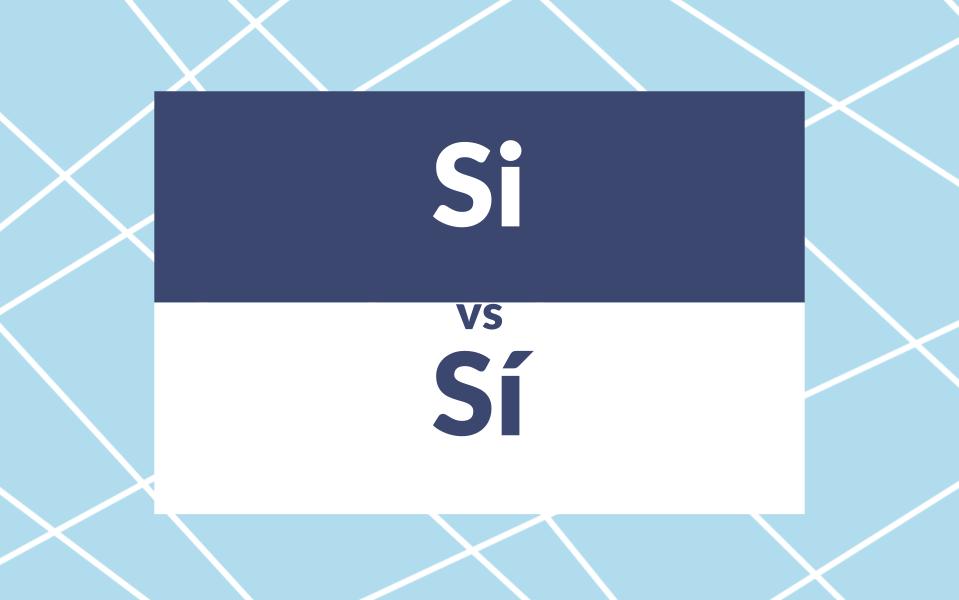Si vs Sí: Learning to use the right Si in Spanish

Get our free email course, Shortcut to Conversational.
Have conversations faster, understand people when they speak fast, and other tested tips to learn faster.
More infoAt first glance, you might wonder if we’re referring to the same word when we mention si vs sí. The crucial difference here is the accent mark, which distinguishes them as two distinct words.
It’s likely that you’ve heard the word si in Spanish conversations, but was it the sí with the accent, or the unaccented si? Since they’re both pronounced identically, and both sí and si have multiple possible meanings, it’s easy to get these Spanish homophones confused.
So is it si or sí? Don’t worry, we’re here to clear things up. In today’s post we will explore all the meanings between si vs sí to help you use them correctly in your Spanish conversations and writing!
Sí with an accent
The word sí with an accent has several uses. Its most common use is as the Spanish word for yes, which is technically considered an affirmative adverb. It can also be used with a similar meaning as a noun, or with a completely different meaning as a reflexive pronoun.
Now let’s see each of these uses of sí with an accent.
Sí as an affirmative adverb
As a standalone word, sí is the Spanish equivalent of yes, used to respond affirmatively to a question or statement.
- Are you going to the party tonight? / Yes, I am going. – ¿Vas a la fiesta esta noche? / Sí, voy.
- Did you know this word already? / Yes. – ¿Ya concías esta palabra? / Sí.
Sí is also used to confirm a positive contrast to a negative statement.
- My dad doesn’t like carrots, but my mom does. – A mi papá no le gustan las zanahorias, pero a mi mamá sí.
Sí as a noun
When sí implies approval, it can be used as a masculine noun by preceding it with an article, or by introducing it after “que.”
- She gave him the yes when he asked her in marriage. – Ella le dió el sí cuando le pidió que se casara con ella.
- You told me a yes, that you did want to buy this house. – Tú me dijiste que sí, querías comprar esta casa.
Sí as a reflexive pronoun
In certain sentence structures, sí with an accent can function as a third-person reflexive pronoun. Only used as a reflexive counterpart to él, ella, ellos, and ellas, sí us usually translated as himself, herself, or themselves.
This reflexive pronoun is not used with standard reflexive verbs such as “lavarse.” Sí as a pronoun is rather used when the individuals in the sentence are taking on some level of reflection on the self, or otherwise applying some action to themselves.
With this in mind, the best indication to use sí as a pronoun is that it is preceded by a preposition.
- The child has a lot of confidence in herself. – La niña tiene mucha confianza en sí.
- They pushed all criticisms away from themselves. – Ellos alejaron de sí todas las críticas.
Sí can also be followed by the adjectives mismo and solo to give even more emphasis to the reflexive nature of the action. These adjectives must agree in gender and number with the subject.
Sí mismo is used when talking about an action the subject applies to themself.
- They define themselves as philanthropists. – Ellos se definen a sí mismos como filántropos.
- She told herself she wasn’t going to cry about it ever again. – Ella se dijo a sí misma que no iba a llorar por eso nunca más.
When we really want to emphasize the person responsible for an action, we can say por sí mismo or por sí solo to indicate that the action was done by that person themself.
- Girls know how to stand on their own. – Las chicas saben valerse por sí solas.
- The members must decide the future president for themselves. – Los miembros deben decidir por sí mismos al futuro presidente.
Finally, we can use the locution entre sí to refer to people who are doing an action together. The subject must always be plural. The English translation can be variants of between themselves, amongst themselves, one another, or each other.
- The kids are talking amongst themselves. – Los niños hablan entre sí.
- They help one another. – Ellas se ayudan entre sí.
Si without accent
Just like we saw with the accented “sí,” without the accent, si in Spanish also has a couple of different meanings. Si means if or whether in most circumstances, but it can also be used as a noun to describe a specific musical note!
Si as a conjunction
Si is primarily used as a conditional conjunction to introduce conditional clauses. In most such contexts, si is translated as if in English.
We go into a lot more detail on exactly how to use this unaccented si in Spanish in our posts on the conditional tense and on si clauses in Spanish.
- If you want to go to the park, you must do your homework first. – Si quieres ir al parque, debes hacer tu tarea primero.
- If I knew how to swim, I would go scuba diving in the Caribbean. – Si supiera nadar, bucearía en el Caribe.
Si can also mean whether when used to ask indirect questions with a couple of possible options.
- Please ask Vanessa whether she is coming to the meeting or not. – Por favor, pregúntale a Vanessa si viene a la reunión o no.
- I don’t know whether I like the blue dress or the pink one better. – No sé si me gusta más el vestido azul o el rosado.
Si as a musical note
Finally, si in Spanish also represents the seventh note in the musical scale, which in English is known as B.
English speakers may recognize this name of the note from the song where you learn the notes by singing the scale as “do-re-mi-fa-so-la-ti-do.” In Spanish the musical scale is known by the equivalent: “do-re-mi-fa-sol-la-si-do.” Whereas in English these same notes are usually referred to by their letters, C-D-E-F-G-A-B-C, in Spanish they’re best known by these words!
Hence, si in Spanish is often sung as a note!
Conclusion
There you have it, now you have totally mastered si vs sí. How about a quick recap before we say goodbye?
Sí with an accent serves as an affirmative adverb, and to express positive affirmation or agreement, best translated as yes. In this same sense, el sí can be used as a noun to mean the yes. Sí can also function as the reflexive of the pronouns él, ella, ellos, and ellas when preceded by a preposition. In this usage, sí is commonly combined with “mismo” and “solo” to add emphasis to the person the reflexive pronoun refers to.
On the other hand, si without an accent primarily functions as a conditional conjunction, best translated as if, used to introduce conditional sentences or ask indirect questions. Additionally, si in Spanish also represents the note “B” on the musical scale.
Now that you know whether to go for si or sí, you’ll always know when to use the accent or not. With that in mind, we’ll leave you with these words of encouragement:
¡Sí se puede! – Yes we can!



